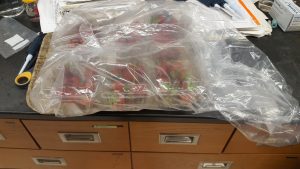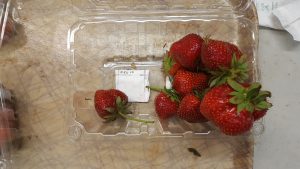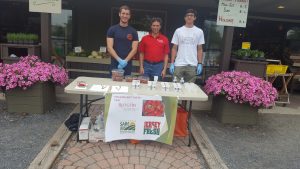Progress report for LNE18-369R
Project Information
Strawberry harvest in the Northeast is limited to a three -week period on average. There is a need to extend the season for growers. One way to extend the season is to contain postharvest losses. Currently, there is no postharvest treatment for strawberry. In the northeast, most of the strawberry production is for the fresh market with 3,911 acres in production.
To solve this problem, we have developed sachets containing essential oils encapsulated into cyclodextrin which are fitted to clamshells to control disease. Thyme oil is known to control gray mold and other fungal diseases. These sachets are combined with modified atmosphere packaging (MAP) to prevent water loss of fruit. The research was conducted at four local farms in central NJ. The essential oil sachet reduced postharvest disease incidence and the MAP reduced water loss of the fruit after seven days cold storage. No off-flavors or aromas were detected in consumer taste tests conducted with consumers at the farms market. The results of this research were presented to growers and agricultural service providers at the Vegetable Growers Convention in Atlantic City, NJ in both 2019 and 2020.
To demonstrate that our two-component packaging technology will extend the fresh strawberry market season in the Northeast, and will improve inventory management allowing for berries to be picked for later use or in advance of bad weather. Harvesting of all fresh berries would allow for less wasted production left in the field resulting in more efficient land use and production.
Strawberry harvest in the Northeast is limited to a three -week period on average. There is a need to extend the season for growers. One way to extend the season is to contain postharvest losses. Currently, there is no postharvest treatment for strawberry. In the northeast, most of the strawberry production is for the fresh market with 3,911 acres in production. The total value for strawberry production is $34.52 million.
To solve this problem, we have developed sachets containing essential oils encapsulated into cyclodextrin (CD) which are fitted to clamshells to control disease. Thyme oil is known to control gray mold and other fungal diseases. These sachets are combined with modified atmosphere packaging (MAP) to prevent water loss of fruit. This project will bring the technology to the strawberry grower, demonstrating increased fruit freshness and storage life by evaluating disease, fresh weight and fruit firmness, for postharvest treatment with anti-microbial sachets and MAP compared to conventional storage, and through surveys after taste tests by farmers and consumers.
Cooperators
Research
Incorporation of our postharvest technology will improve freshness and quality and extend product shelf life.
Procedures
Essential Oil Sachets, and MAP
Controlled release TyvekTMsachets of thyme oil (TO) or oregano oil (OO), encapsulated by b-cyclodextrin (CD) at a ratio of 16:84 were made. Clamshells were fitted with 2 sachets (0.5g TO:CD) each. MAP bags and CO2 emitters were purchased from Multisorb (Bridgewater, NJ).
Plant materials
Strawberry fruit were harvested from three local commercial sources and either transported to the laboratory at Rutgers University, New Brunswick, NJ or stored at harvest location. The fruit were sorted so as to select only well formed, rot free, unblemished fruit with intact calyxes.
Treatments
Units of approximately 20 fruit were selected and placed in clamshells outfitted with TO:CD, OO:CD, or CD sachets. The clamshells fitted with sachets and fruit and some were sealed in MAP bags. Two CO2 emitters were included with the fruit sealed in MAP bags. ibutton data loggers were used. The samples were stored at 4 °C and 90% RH and tested at day 7 of storage.
Weight losses
Change in package weight for the different treatments of strawberry was measured over storage time.
Fruit Firmness
A hand held fruit pressure tester (FT 011, Mc Cormack, Italy) fitted with a 3 mm plunger tip was used to measure fruit firmness over storage time.
Soluble solids content
The total soluble solids (TSS) content of the strawberry homogenate was measured with a portable refractometer (Fisher Scientific, Suwanee, GA, USA). The results were expressed as degrees Brix.
Fungal decay
Gray mold was visually estimated in each individual fruit right after opening the packages. Strawberry fruits showing surface mycelial development were considered decayed. The results will be expressed as percentage of fruits infected by Botrytis.
Taste test
A taste test was performed on the fruit after one week of cold storage. The taste test was performed at three different locations. There were a total of 78 participants. Participants were given a fruit from selected treatments and asked to rate the fruit from 1 to 5 with 5 being the best for freshness, aroma, sweetness, and flavor. Participants were also asked which treated strawberry would they buy.
Statistical Analysis
Data for the physical, chemical and microbiological parameters was subjected to 2 way anova without replicate followed by post hoc Bonferroni comparison to test significant differences between means with p<0.05. The proof of concept will be considered successfully achieved if the treatments are statistically significant compared to the controls.
4 cm x 4cm TyvekTM sachets were filled with 0.5g TO:CD, or OO:CD prepared from a ratio of 16:84 TO:CD or OO:CD and heat sealed. Alternatively, 4 cm x 4cm TyvekTM sachets were filled with 0.5g CD (control) and heat sealed. Two sachets were adhered to the bottom of a clamshell package and 20 strawberries were added. Some of the clamshells were then enclosed in MAP bags with CO2 emitters and placed in a 4 °C cold storage room for 7 days. Each treatment had six replicates and was repeated three times. The results for Thyme oil (TO) are shown in Table 1.
| Treatment | Farm 1 | Farm 2 | Farm 3 | |||
| % initial fresh wt | No bag no oil | 96.1b | 96b | 95.3b | ||
| Bag No TO | 99.7a | 99.8a | 99.7a | |||
| TO No bag | 96.4b | 94.9c | 95.2b | |||
| Bag +TO | 99.7a | 99.7a | 99.6a | |||
| % Disease | No bag no oil | 17.7a | 6.5a | 12.4a | ||
| Bag No TO | 18.9a | 8.5a | 6.5a | |||
| TO No bag | 12.9ab | 6.4a | 10.8a | |||
| Bag +TO | 5.9b | 6.1a | 6.7a | |||
| Firmness (N/cm2) | No bag no oil | 7.5b | 10.3a | 8b | ||
| Bag No TO | 11.8a | 8.9a | 9.8a | |||
| TO No bag | 9.1b | 10.1a | 8.6b | |||
| Bag +TO | 12.5a | 8.6a | 10a | |||
| Brix (SSC) | No bag no oil | 5.6a | 8.6a | 8.8a | ||
| Bag No TO | 5.6a | 8.0a | 7.7a | |||
| TO No bag | 5.1a | 8.8a | 8.3a | |||
| Bag +TO | 5.8a | 7.2a | 7.3a | |||
The results for the Oregano oil (OO) are shown in Table 2.
| % initial fresh wt | OO No bag | 94.2c | 95.9c | 95.0b |
| Bag OO | 99.6a | 99.7a | 99.7a | |
| % Disease | No bag No oil | 17.1a | 4.2a | 12.4a |
| Bag No OO | 21.5a | 6.4a | 9.7a | |
| OO No bag | 9.8a | 5.9a | 24.4a | |
| Bag OO | 9.0a | 2.9a | 8.8a | |
| Firmness (N/cm2) | No bag No oil | 10.7a | 8.4a | 8.8a |
| Bag No OO | 11.7a | 9.1a | 9.8a | |
| OO No bag | 10.9a | 8.8a | 9.1a | |
| Bag OO | 11.8a | 9.6a | 10.1a | |
| Brix (SSC) | No bag No oil | 5.6a | 9.1a | 7.7a |
| Bag No OO | 5.9a | 9.0a | 7.9a | |
| OO No bag | 5.8a | 8.0a | 7.2a | |
| Bag OO | 5.8a | 8.7a | 7.5a | |


As in year one, fruit which is stored in MAP bags has less weight loss than fruit stored in clamshells alone (Table 1 and 2). The combination of MAP bags and thyme oil were effective in reducing disease at farm 1 (Table 1). Disease levels were lower at farm 2 and farm 3 but not statistically significant (Table 1). Firmness was maintained in two of the three farms when the fruit were stored in MAP. Brix values (soluble solids) was unafected by treatment but did vary among the farms. The combination of MAP bags and oregano oil were not statistically effective in reducing disease though there was less disease seen on a percentage basis with this treatment (Table 2). MAP bags also reduced fruit weight loss during storage. The MAP bags had no effect on disease, firmness, or Brix. The essential oils, thyme and oregano, had no effect on weight loss, firmness, or Brix. Thyme and oregano oil alone had no effect on disease. Consistent with the data from year 1, the most effective treatment
An unexpected finding this year is that there was no difference in disease incidence between fruit not stored in bags and in bags (Table 1 and 2). Fruit stored in bags had less weight loss after 7 days of storage. Higher weight fruit would result in greater profit for growers.
Taste test
Three taste tests were performed at three different locations. Strawberries that were either freshly harvested or stored for one week with either CD, TO:CD, or OO:CD were used for the taste test. Participants were given a numbered cup fitted with a strawberry. They were asked to rate the berry for freshness, aroma, sweetness, and flavor. Between treatments, participants were asked to clean their palates with water. The results for the taste test are shown in Table 3.
| Flavor | Fresh picked strawberry | 3.8a | 3.9a | 3.9a | |
| Bag No oil | 3.7a | 3.5a | 3.6a | ||
| Bag+ TO | 3.4a | 3.7a | 3.7a | ||
| Bag +OO | 3.6a | 3.3a | 3.5a | ||
| scale 1 to 5; 5 best | p < .05 | ||||
Participants were also asked which treatment would they buy. The results are shown in Table 4.
| Consumer preference | Fresh picked strawberry | Bag No oil | Bag +TO | Bag +OO | Chi Square significance and student t test | |||
| 30 * | 13 | 16 | 19 | |||||
| * p < .05 | ||||||||

The results from Table 3 indicate that participants could not discern differences in freshness, aroma, flavor, and sweetness between the different treatments. The data is shown for flavor only as an example. While there were not any differences in organoleptic properties, participants indicated that they would be more inclined to purchase freshly harvested strawberries compared to the stored fruit (Table 4). Although freshly picked was preferred by more participants, some picked the other treatments indicating that the essential oil treatments did not have significant negative effect on fruit flavor.
There is considerable consistency in the results from two years’ field experiments at four different commercial strawberry farms in 2018 and 2019. The most useful treatment to preserve fruit fresh weight and postharvest quality was modified atmosphere packaging (MAP). MAP reduced the loss in fresh weight during cold storage for seven days in both years and for all farms. Typically fruit that were enclosed in MAP lost less than 0.3% of their initial fresh weight, whereas fruit left in trays in the cold room, the standard postharvest conditions, lost more than 5% of their fresh weight. This fresh weight loss is accompanied by a darkening in fruit appearance and a loss in glossiness compared to freshly picked strawberries. A future project will quantify these observations made on fruit darkening and loss of glossiness during postharvest storage. A reduction in disease incidence was also consistently observed with thyme or oregano oil sachets. There were some exceptions to this data. Within either year or farm, a statistically significant reduction in disease resistance was not recorded, if disease pressure was very low within farm location or year, a reduction in disease compared to control was not significantly different. Also in both years, there was little effect of treatments on fruit firmness and acidity (Brix value) during seven days postharvest cold storage. Results for oregano oil for disease control were similar to thyme oil. Both essential oils contain many common chemical constituents known to have antimicrobial activity. Growers have been reluctant to use plastic packaging during cold storage because it may create an environment conducive to pathogen growth. The results of this project demonstrate that when MAP is used, especially in combination with essential oil sachets, disease incidence is often reduced compared to standard storage practices.
One concern with the use of essential oils for disease control is the potential for off-flavors or aromas imparting an herbal taste to strawberry fruit. In both years taste tests were conducted with consumers at farm markets. Treatment comparisons were made against freshly picked strawberries. Consumers preferred the freshly picked fruit; compared to the seven-day old stored fruit, but almost no one (2 out of 140) detected an herbal off-flavor or aroma. These data indicate clearly that given the treatment and storage protocol in this project, off-flavors and aromas should not be of concern to growers.
Education & Outreach Activities and Participation Summary
Educational activities:
Participation Summary:
The PI gave talks at the annual vegetable and small fruit grower meeting and state agricultural congress in Atlantic City NJ in both 2019 and 2020. This is the largest attended agricultural grower meeting in NJ. Our talk was attended by approximately 50 growers and agricultural services providers each year.
Now that the project has been completed, the results will be submitted to a peer-reviewed horticulture journal for publication.
Learning Outcomes
Farmers and service providers gained knowledge in postharvest handling of small fruit to maintain freshness, reduced disease incidence and extend shelf as a result of the demonstration at their farm and through the presentations made at the annual vegetable and small fruit conference in both 2019 and 2020
Project Outcomes
One of the short comings of the project is that the essential oil sachets are not commercially available. Growers can use the MAP component, but we need to find a company that will make the essential oil sachets. I have approached two companies that make products to extend postharvest quality of fruits, vegetables or cut flowers, and I hope that they will be interested in our technology when the data is published.